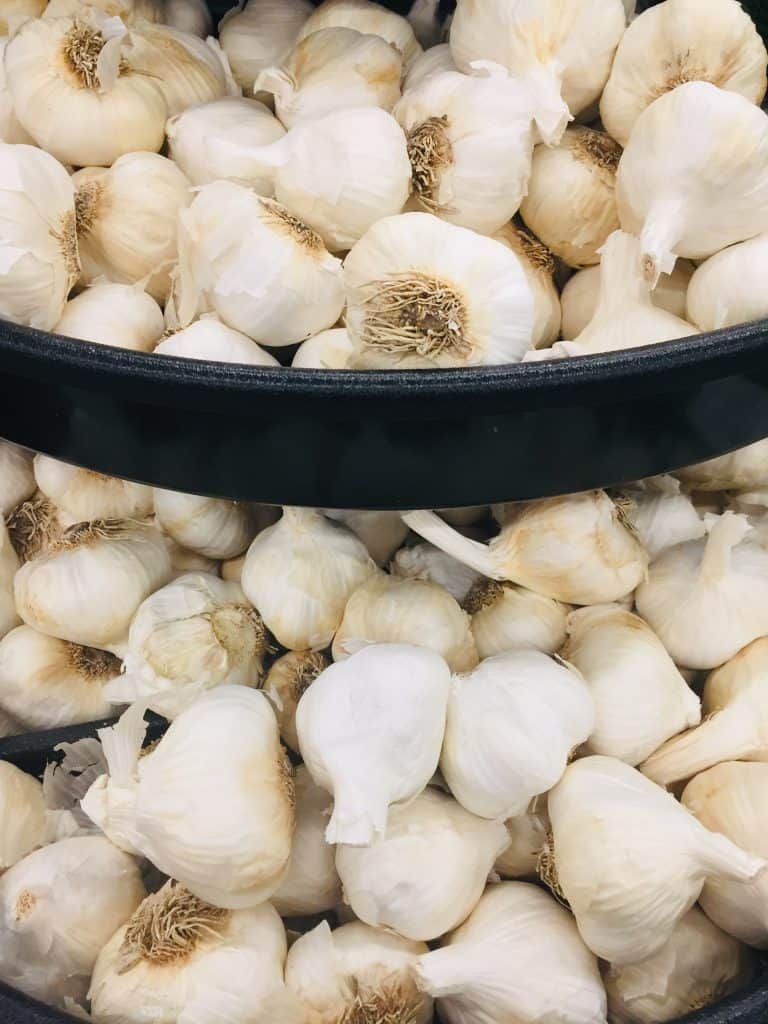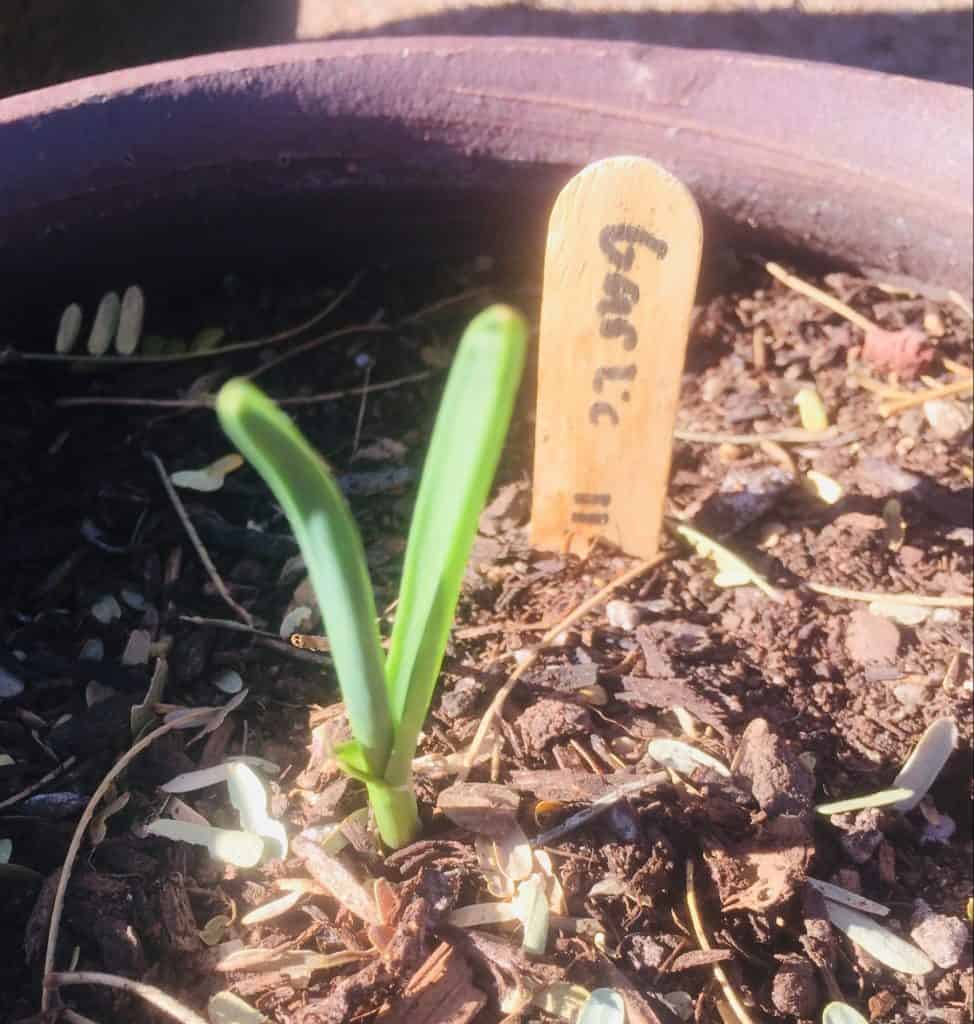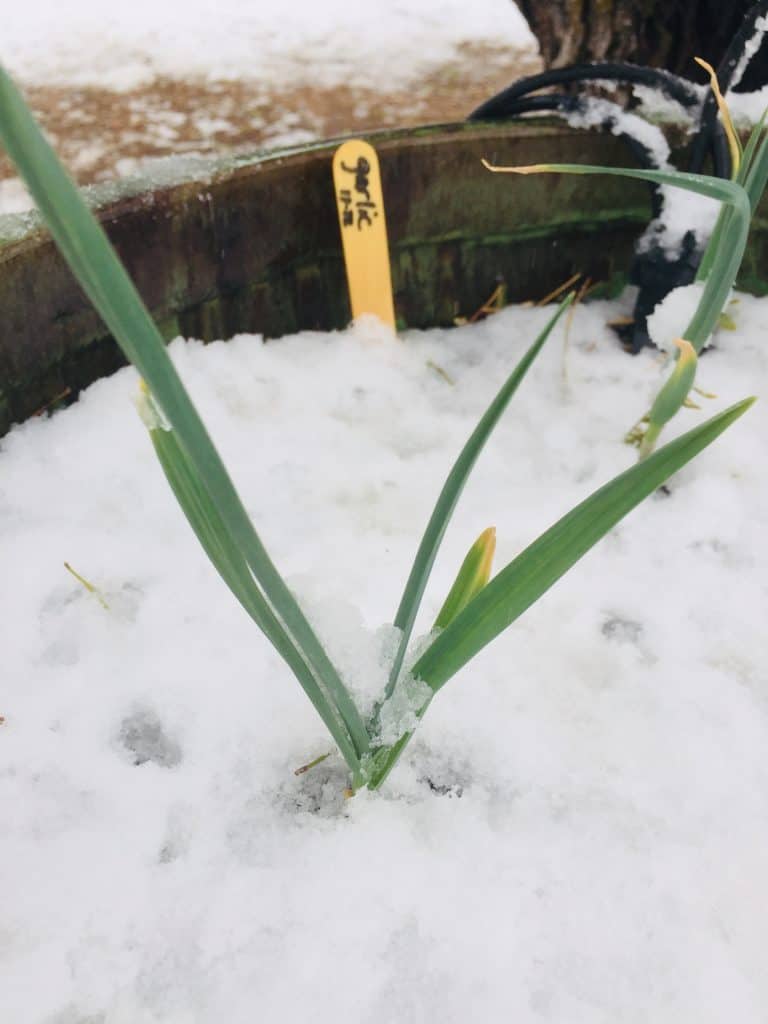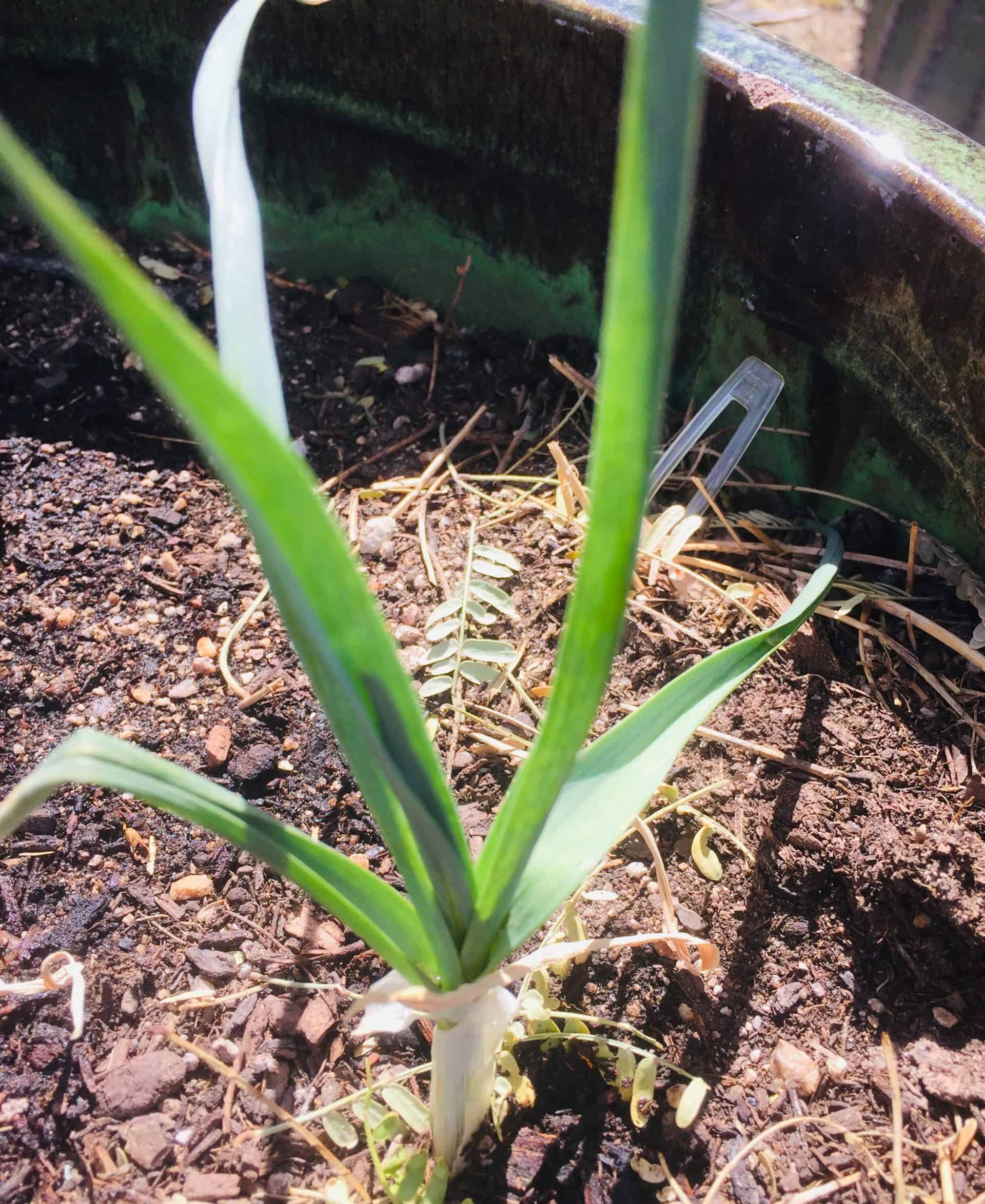Learn how to grow garlic from a clove. Once planted, one clove will yield an entire bulb. Growing garlic is easy. It’s low maintenance and perfect for beginners.
In addition, it doesn’t take a lot of space in the garden. Garlic grows well in pots.
Garlic is a cool season crop and requires a cold period to grow. The bulbs grow underground and are moderately tolerant to frost.
One of the best things is mammals won’t eat it from your garden. Garlic is deer-resistant. In addition, it won’t appeal to raccoons, rabbits, and rodents either.
You’ll need patience though. It takes 7 – 8 months (210 – 240 days) to harvest.
Typically, home gardeners grow garlic from cloves, not from garlic seeds.
Store-bought garlic will work fine. Buy organic garlic if you can find them. Or you can buy seed garlic (bulbs with cloves to plant) from a nursery specifically to regrow.
Here’s how to plant garlic for an abundant crop. It stores well so you may want to grow a lot to enjoy all year.
Growing Garlic
The scientific name for garlic is Allium sativum. It’s a perennial often grown as an annual. While it’s considered an herb to season foods, it’s botanically a vegetable.
Garlic grows in bulbs which are also called heads of garlic. Each bulb contains approximately 10 or 12 cloves.
To grow garlic, separate the cloves, and plant each clove individually.
You won’t be able to see the bulb growing underground but it will start to form roots. In time, you will see the garlic plant break through the surface.
How to Grow Garlic
1. Decide if you are planting garlic in a container, garden bed, or in the ground.
2. Choose either hardneck garlic or softneck garlic bulbs from:
- Grocery store: Buy organic
- Garden center or nursery: Buy seed garlic
- Seed company: Choose seed garlic
No matter your hardiness zone, garlic should grow well.
- Warmer regions, growing in the south = softneck garlic
- Colder regions, growing in the north = hardneck garlic
Buy a few heads if possible. You’ll want to choose the largest cloves from each garlic head.
3. Cloves need a vernalization period — a cooling period — in order to grow optimally.
Vernalization will happen naturally if you plant them outdoors in colder regions. If you live in a warm climate, you’ll need to chill them in the refrigerator.
This means:
If you live in a colder region, planting the cloves in the soil may be okay. This is generally climate zones 1 – 5, sometimes 6.
If you live in a warmer area, with a plant hardiness zone of 6, 7 and higher, you’ll need to put the garlic in the refrigerator for 5 – 10 weeks. Cold temperatures will encourage growth.
4. Open the head of garlic, and chose the largest cloves to plant. Keep the papery layer intact. Do not peel it away.
5. Plant the pointy side up and the flat side down. Space individual cloves every 4 – 6 inches. Plant them two inches deep.

Planting Garlic
Here’s what to know about planting garlic:
Where to grow
Garlic grows well in pots and containers. It will also do well right in the ground or in a garden bed. It depends on the soil, watering, air temperature, and sunlight.
Sunlight
It requires a minimum of six hours of direct sunlight per day. If you plant it in pots and containers, consider moving them to maximize sunlight. The plants will do well in full sun.
Soil requirements
Be sure to use quality, nutrient rich soil. Soil matters. Plant in fertile, well-draining soil with neutral pH level. Loamy soil is ideal. Plants can also tolerate some clay. The key is that it drains well.
You can use potting soil. The top six inches of soil should be enriched with organic matter including a layer of compost.
Soil temperature should be around 50 degrees F when planting.
What month to plant garlic
- In warmer climates: Plant garlic late October, November, or December.
- In cooler climates: Plant garlic in September, October, or November.
Ideally, you should plant garlic one month before the ground freezes.
While you may be used to planting right after the last frost, with garlic, the best time to plant garlic is before the first frost.
In North America, this means planting in the fall as it starts to get colder and not in the spring as it starts to warm up.
Optimum air temperature is 32 – 50 degrees Fahrenheit during the first 60 days after planting the cloves.
Roots will develop during the colder months. Growing outdoors or indoors
If you have properly vernalized the garlic, you can garlic grow in pots indoors or in a greenhouse.
Growing Garlic in Pots
Choose a container that’s a least 8 inches deep. If has a diameter of 8 inches or more, you can plant several cloves.
Be sure it has adequate drain holes as garlic plants don’t like to be wet.
Garlic plants are ideal to grow in pots indoors or outdoors.
Growing garlic in pots means you can grow it on the patio, deck, windowsill, and other small spaces. You can also move the container around to a sunny spot to maximize sunlight. It’s ideal for a mini garden on the balcony.
If you use new potting soil, there will also be less chance of pests such as nematodes and fungal diseases.

Other Things to Know for a Successful Yield
Overall, growing garlic is easy. It’s ideal for beginner gardeners as it doesn’t require much upkeep. It’s among the easiest foods to grow.
Hydroponics
You can grow garlic with hydroponics with proper lighting and substrate.
Companion plants
Being garlic is a cool season crop, consider your plant hardiness zone and what else grows in the cooler months. Garlic pairs well with cabbage and spinach.
It will also do well on its own, among other garlic plants.
Mulch
Put down a layer of mulch such as alfalfa, leaves, hay, or straw. Mulch will do many things to help garlic plants.
In the summer months, it will help retain moisture and prevent weeds. Mulch for winter will help provide warmth and protects nutrients in the soil.
Planting the clove
Before you plant the clove, it’s important to look at both ends. Plant the pointy side up and the flatter side down to grow roots.
Spacing
When planting, space each garlic clove at least four inches apart. If you have space, six or eight inches apart is better.
If planting in rows of garlic in a garden, space rows 12 inches apart.
Fertilizer
Fertilize garlic in the spring. Ask at your local garden center for a recommendation. Otherwise, choose one that’s high in nitrogen. You can also add fish meal, blood meal, or bone meal. Choose organic fertilizer when possible.

Watering
Garlic require less water in the colder months and more when it’s warm. It’s important not to overwater so they don’t get root rot.
On average, water once a week. Plan on watering half an inch to one inch per week. Consider the rainfall each week as well. If possible, remove snow as well.
Seed garlic
Seed garlic isn’t the same as garlic seeds. Seed garlic are the bulbs you buy from a garden center to be sure they aren’t treated with growth inhibitors. They are grown to be replanted.
Pests and diseases
Most animals won’t eat the plants which is good news. Some may dig it up. Insects and pests to watch out for include leaf miners, bulb mites, nematodes, and more.
Harvesting Garlic
When to harvest garlic
It takes 7 months or longer to grow garlic. Be sure to note when you planted it. It will be ready for a summer harvest, typically June and July.
Whether you planted hardneck or softneck garlic, it’s harvest time when about half the leaves turn yellow. The lowest leaves should wither and turn brown. Then it’s time to pick the underground bulbs. If you are growing hardneck and see a long curling stem, that’s called a scape. Scapes are edible as well.
How to harvest garlic
Root around with your hands or use a garden fork or small hand shovel to gently work out each bulb. Don’t pull them out from the stem and leaves. Start from the bottom and work your way up.
Loosely shake the dirt from the bulbs. It’s important to not wash the dirt off.
Be gentle and don’t disrupt the papery skins. Keeping them intact will increase the time you can store them.
You may want to harvest one or two to see how mature they are before picking all of them.
How to Store Garlic
Put aside some garlic you will use in the first month. You can leave it on the kitchen counter, in the refrigerator, or in a cool and dry place.
If you want to store it longer, cure it first. Hang garlic in bunches for around 3 weeks to cure. It’s best to hang them in a place that won’t get light. Hang the garlic plant, including the roots and stalk, with the bulb side down.
If you grow larger bulbs, let them cure for a month.
How long does garlic last
Homegrown heads of garlic can last up to six months in a cool and dry space. Ideal temperature to store garlic is between 32 – 50 degrees F with relative humidity of around 50%. It’s best to keep the bulbs intact until you are ready to use them. They’ll stay fresher and be more flavorful.
If you want to store them for several months, pick them when the leaves turn yellow and before the tops collaspe. If the cloves are bursting from the white sheath, they won’t last as long in storage as ones where the bulbs are still fully contained.
Types of Garlic
Before considering garlic varieties, it’s important to know there are two types of garlic:
- Hardneck
- Softneck
You may not want to get too hung up on the type of garlic plant. The important thing is that it will grow well in your area. If you buy store-bought garlic, you may not have much choice.
Difference between hardneck garlic vs softneck garlic
The difference between these types of garlic is their hardiness and the way the plant grows. Hardneck garlic is better suited for cooler climates. Softneck garlic is better suited for warmer climates.
Regarding the garlic plant, hardneck has one central flowering stem, a scape, from which leaves grow. As it grows, the stem hardens. With softneck, there isn’t a central stalk. Several “soft” leaves grow instead.
Varieties of garlic
Softneck garlic
- Smaller cloves than hardneck
- Cloves are bunched together and not around the stem; there is a layer of cloves
- Needs vernalization period — cold exposure to grow optimally
- Better suited to warmer climates
- Typically what you see at the grocery store; often will find California Early or California Late
- Longer shelf-life than hard neck
Softneck varieties
Some varieties include:
- Albigensian Wight
- Blanco Veneto
- California Early
- California Late
- Early Purple Wight
- Iberian Wight
- Inchelium Red
- Silverskin
- Solent Wight
Hardneck garlic
- Larger cloves than soft neck
- Cloves grow one ring around the stem in a single row to form the head
- Grows with one long stem and scapes (flower stems and buds)
- Peel easier than softneck
- Cold hardy; plant if you have cold winters
- More complex flavor
Hardneck varieties
There are three main types: Porcelain, Purple Stripe, and Rocambole. Some varieties include:
- German Extra Hardy
- Siberian
- Georgian Crystal
- Spanish Roja
We don’t discuss elephant garlic which is milder. It isn’t true garlic. It’s more closely related to leeks than to garlic.
Growing Garlic FAQs
Can I plant garlic from the grocery store?
Store-bought garlic works fine, especially if it’s already growing on your kitchen counter. Choose organic if possible. Choose the largest cloves to plant. Separate cloves gently. Plant cloves with the pointy side facing up.
How long does garlic take to grow?
Garlic takes between 7 – 9 months to grow so patience is key. In most areas, this means you plant in autumn and harvest plump cloves in late spring and into summer.
Does garlic need a lot of water?
Water garlic weekly. It requires half inch to one inch per week. It requires less water 7 – 14 days before harvest.
How to Grow Lots of Garlic
The best thing is to buy seed garlic from a garden center. However, you can plant organic cloves as well. It’s important to plant the biggest cloves from the head as they will grow the largest bulbs.
This is an easy-to-grow crop that stores well. It’s a great to plant with your winter vegetables. It’s something you can grow if you have garden pests without them eating it.
The great thing is once you have a successful crop of garlic, you can replant some of the cloves to grow additional bulbs the next year. You’ll be on your way to a productive garlic farm.
There’s nothing like homegrown garlic. The taste and flavor is supreme. Plus you’ll have the satisfaction of having grown it yourself!

